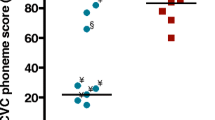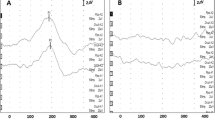Abstract
Purpose
To investigate the effect of the interval between bilateral cochlear implantation on the development of bilateral peripheral auditory pathways as revealed by the electrically evoked auditory brainstem response (EABR).
Methods
Fifty-eight children with profound bilateral sensorineural hearing loss were recruited. Among them, 33 children received sequential bilateral cochlear implants (CIs), and 25 children received simultaneous bilateral CIs. The bilateral EABRs evoked by electrical stimulation from the CI electrode were recorded on the day of second-side CI activation.
Results
The latencies of wave III (eIII) and wave V (eV) were significantly shorter on the first CI side than on the second CI side in children with sequential bilateral CIs but were similar between the two sides in children with simultaneous bilateral CIs. Furthermore, the latencies were prolonged from apical to basal channels along the cochlea in the two groups. In children with sequential CIs, the inter-implant interval was negatively correlated with the eV latency on the first CI side and was positively correlated with bilateral differences in the eIII and eV latencies.
Conclusions
Unilateral CI use promotes the maturation of ipsilateral auditory conduction function. However, a longer inter-implant interval results in more unbalanced development of bilateral auditory brainstem pathways. Bilateral cochlear implantation with no or a short interval is recommended.



Similar content being viewed by others
Data availability
The data that support the findings of this study are available from the corresponding author upon reasonable request.
References
Lieu JEC, Kenna M, Anne S, Davidson L (2020) Hearing loss in children: a review. JAMA 324(21):2195–2205. https://doi.org/10.1001/jama.2020.17647
Asp F, Maki-Torkko E, Karltorp E, Harder H, Hergils L, Eskilsson G, Stenfelt S (2012) Bilateral versus unilateral cochlear implants in children: speech recognition, sound localization, and parental reports. Int J Audiol 51(11):817–832. https://doi.org/10.3109/14992027.2012.705898
Culling JF, Jelfs S, Talbert A, Grange JA, Backhouse SS (2012) The benefit of bilateral versus unilateral cochlear implantation to speech intelligibility in noise. Ear Hear 33(6):673–682. https://doi.org/10.1097/AUD.0b013e3182587356
Laske RD, Veraguth D, Dillier N, Binkert A, Holzmann D, Huber AM (2009) Subjective and objective results after bilateral cochlear implantation in adults. Otol Neurotol 30(3):313–318. https://doi.org/10.1097/MAO.0b013e31819bd7e6
Eskridge HR, Park LR, Brown KD (2021) The impact of unilateral, simultaneous, or sequential cochlear implantation on pediatric language outcomes. Cochlear Implants Int 22(4):187–194. https://doi.org/10.1080/14670100.2020.1871267
McRackan TR, Fabie JE, Bhenswala PN, Nguyen SA, Dubno JR (2019) General health quality of life instruments underestimate the impact of bilateral cochlear implantation. Otol Neurotol 40(6):745–753. https://doi.org/10.1097/MAO.0000000000002225
Lammers MJ, Venekamp RP, Grolman W, van der Heijden GJ (2014) Bilateral cochlear implantation in children and the impact of the inter-implant interval. Laryngoscope 124(4):993–999. https://doi.org/10.1002/lary.24395
Boons T, Brokx JP, Frijns JH, Peeraer L, Philips B, Vermeulen A, Wouters J, van Wieringen A (2012) Effect of pediatric bilateral cochlear implantation on language development. Arch Pediatr Adolesc Med 166(1):28–34. https://doi.org/10.1001/archpediatrics.2011.748
Chadha NK, Papsin BC, Jiwani S, Gordon KA (2011) Speech detection in noise and spatial unmasking in children with simultaneous versus sequential bilateral cochlear implants. Otol Neurotol 32(7):1057–1064. https://doi.org/10.1097/MAO.0b013e3182267de7
Illg A, Giourgas A, Kral A, Buchner A, Lesinski-Schiedat A, Lenarz T (2013) Speech comprehension in children and adolescents after sequential bilateral cochlear implantation with long interimplant interval. Otol Neurotol 34(4):682–689. https://doi.org/10.1097/MAO.0b013e31828bb75e
Gordon KA, Papsin BC (2009) Benefits of short interimplant delays in children receiving bilateral cochlear implants. Otol Neurotol 30(3):319–331. https://doi.org/10.1097/MAO.0b013e31819a8f4c
Strom-Roum H, Laurent C, Wie OB (2012) Comparison of bilateral and unilateral cochlear implants in children with sequential surgery. Int J Pediatr Otorhinolaryngol 76(1):95–99. https://doi.org/10.1016/j.ijporl.2011.10.009
Gordon KA, Valero J, van Hoesel R, Papsin BC (2008) Abnormal timing delays in auditory brainstem responses evoked by bilateral cochlear implant use in children. Otol Neurotol 29(2):193–198. https://doi.org/10.1097/mao.0b013e318162514c
Gordon KA, Valero J, Papsin BC (2007) Binaural processing in children using bilateral cochlear implants. NeuroReport 18(6):613–617. https://doi.org/10.1097/WNR.0b013e3280b10c15
Gordon KA, Valero J, Papsin BC (2007) Auditory brainstem activity in children with 9–30 months of bilateral cochlear implant use. Hear Res 233(1–2):97–107. https://doi.org/10.1016/j.heares.2007.08.001
Koo TK, Bartels LJ, Allen KP, Danner CJ (2020) The relationship of inter-implant time and hearing outcomes for bilateral cochlear implants. Am J Otolaryngol 41(3):102454. https://doi.org/10.1016/j.amjoto.2020.102454
Kim JS, Kim LS, Jeong SW (2013) Functional benefits of sequential bilateral cochlear implantation in children with long inter-stage interval between two implants. Int J Pediatr Otorhinolaryngol 77(2):162–169. https://doi.org/10.1016/j.ijporl.2012.10.010
Gordon KA, Wong DD, Papsin BC (2013) Bilateral input protects the cortex from unilaterally-driven reorganization in children who are deaf. Brain 136(Pt 5):1609–1625. https://doi.org/10.1093/brain/awt052
Kelly AS, Purdy SC, Thorne PR (2005) Electrophysiological and speech perception measures of auditory processing in experienced adult cochlear implant users. Clin Neurophysiol 116(6):1235–1246. https://doi.org/10.1016/j.clinph.2005.02.011
Gallego S, Frachet B, Micheyl C, Truy E, Collet L (1998) Cochlear implant performance and electrically-evoked auditory brain-stem response characteristics. Electroencephalogr Clin Neurophysiol 108(6):521–525. https://doi.org/10.1016/s0168-5597(98)00030-6
Chen L, Zhang JG, Zhu HY, Hou XY, Tang ZQ, Sun JW, Sun JQ, Guo XT (2023) Electrically evoked auditory brainstem responses in children fitted with hearing aids prior to cochlear implantation. Trends Hear 27:23312165221148850. https://doi.org/10.1177/23312165221148846
Zhu HY, Sun JQ, Sun JW, Guo XT (2023) The effect of cochlear size on electrically evoked auditory brainstem responses in deaf children. Laryngoscope Investig Otolarygol 8(2):532–537. https://doi.org/10.1002/lio2.1029
Gordon KA, Papsin BC, Harrison RV (2006) An evoked potential study of the developmental time course of the auditory nerve and brainstem in children using cochlear implants. Audiol Neurootol 11(1):7–23. https://doi.org/10.1159/000088851
Guiraud J, Gallego S, Arnold L, Boyle P, Truy E, Collet L (2007) Effects of auditory pathway anatomy and deafness characteristics? (1): on electrically evoked auditory brainstem responses. Hear Res 223(1–2):48–60. https://doi.org/10.1016/j.heares.2006.09.014
Grothe B, Pecka M, McAlpine D (2010) Mechanisms of sound localization in mammals. Physiol Rev 90(3):983–1012. https://doi.org/10.1152/physrev.00026.2009
Hawley ML, Litovsky RY, Colburn HS (1999) Speech intelligibility and localization in a multi-source environment. J Acoust Soc Am 105(6):3436–3448. https://doi.org/10.1121/1.424670
van Hoesel RJ (2004) Exploring the benefits of bilateral cochlear implants. Audiol Neurootol 9(4):234–246. https://doi.org/10.1159/000078393
Gordon K, Henkin Y, Kral A (2015) Asymmetric hearing during development: the aural preference syndrome and treatment options. Pediatrics 136(1):141–153. https://doi.org/10.1542/peds.2014-3520
Uecker FC, Szczepek A, Olze H (2019) Pediatric bilateral cochlear implantation: simultaneous versus sequential surgery. Otol Neurotol 40(4):e454–e460. https://doi.org/10.1097/MAO.0000000000002177
Dalgic A, Atsal G, Yildirim O, Edizer DT, Ozay MB, Olgun L (2021) Bilateral cochlear implantation in children: simultaneously or in consecutive sessions? J Laryngol Otol 135(4):327–331. https://doi.org/10.1017/S0022215121000931
Sparreboom M, Beynon AJ, Snik AF, Mylanus EA (2010) Electrically evoked auditory brainstem responses in children with sequential bilateral cochlear implants. Otol Neurotol 31(7):1055–1061. https://doi.org/10.1097/MAO.0b013e3181dbb33d
Deniz B, Kara E, Polat Z, Deniz R, Atas A (2021) Changes in electrically evoked auditory brainstem responses in children with sequential bilateral cochlear implants. Int J Pediatr Otorhinolaryngol 141:110555. https://doi.org/10.1016/j.ijporl.2020.110555
Sharma A, Dorman M, Spahr A, Todd NW (2002) Early cochlear implantation in children allows normal development of central auditory pathways. Ann Otol Rhinol Laryngol Suppl 189:38–41. https://doi.org/10.1177/00034894021110s508
Gordon KA, Papsin BC, Harrison RV (2003) Activity-dependent developmental plasticity of the auditory brain stem in children who use cochlear implants. Ear Hear 24(6):485–500. https://doi.org/10.1097/01.AUD.0000100203.65990.D4
Jiwani S, Papsin BC, Gordon KA (2013) Central auditory development after long-term cochlear implant use. Clin Neurophysiol 124(9):1868–1880. https://doi.org/10.1016/j.clinph.2013.03.023
Zhang JG, Chen L, Li P, Sun JW, Guo XT, Sun JQ (2021) Effect of unilateral cochlear implant use on contralateral electrically evoked auditory brainstem responses to round window membrane electrical stimulation. Acta Otolaryngol 141(6):588–593. https://doi.org/10.1080/00016489.2021.1906443
Kishimoto I, Yamazaki H, Naito Y, Moroto S, Yamazaki T (2019) First implant-induced changes in rostral brainstem impair second implant outcomes in sequential bilateral cochlear implant children with long inter-implant delay. Otol Neurotol 40(4):e364–e372. https://doi.org/10.1097/MAO.0000000000002130
Thai-Van H, Cozma S, Boutitie F, Disant F, Truy E, Collet L (2007) The pattern of auditory brainstem response wave V maturation in cochlear-implanted children. Clin Neurophysiol 118(3):676–689. https://doi.org/10.1016/j.clinph.2006.11.010
Gordon KA, Papsin BC, Harrison RV (2007) Auditory brainstem activity and development evoked by apical versus basal cochlear implant electrode stimulation in children. Clin Neurophysiol 118(8):1671–1684. https://doi.org/10.1016/j.clinph.2007.04.030
Raphael Y, Altschuler RA (2003) Structure and innervation of the cochlea. Brain Res Bull 60(5–6):397–422. https://doi.org/10.1016/s0361-9230(03)00047-9
Erixon E, Hogstorp H, Wadin K, Rask-Andersen H (2009) Variational anatomy of the human cochlea: implications for cochlear implantation. Otol Neurotol 30(1):14–22. https://doi.org/10.1097/MAO.0b013e31818a08e8
Glueckert R, Pfaller K, Kinnefors A, Rask-Andersen H, Schrott-Fischer A (2005) The human spiral ganglion: new insights into ultrastructure, survival rate and implications for cochlear implants. Audiol Neurootol 10(5):258–273. https://doi.org/10.1159/000086000
Ekdale EG (2016) Form and function of the mammalian inner ear. J Anat 228(2):324–337. https://doi.org/10.1111/joa.12308
Nadol JB Jr (1997) Patterns of neural degeneration in the human cochlea and auditory nerve: implications for cochlear implantation. Otolaryngol Head Neck Surg 117(3 Pt 1):220–228. https://doi.org/10.1016/s0194-5998(97)70178-5
Shepherd RK, Javel E (1997) Electrical stimulation of the auditory nerve. I. Correlation of physiological responses with cochlear status. Hear Res 108(1–2):112–144. https://doi.org/10.1016/s0378-5955(97)00046-4
Funding
This work was supported by the National Natural Science Foundation of China (Grants 82201278 and 82271180); Natural Science Foundation of Anhui Province (Grants 2208085MH231 and 2008085QH429); and the Key Research and Development Program of Anhui Province (Grant 201904a07020084).
Author information
Authors and Affiliations
Corresponding authors
Ethics declarations
Conflict of interest
The authors declare that they have no conflict of interest.
Ethical approval
All procedures performed in this study involving human participants were in accordance with the ethical standards of the institutional and/or national research committee and with the 1964 Helsinki declaration and its later amendments or comparable ethical standards. The protocols and experimental procedures in the present study were reviewed and approved by the Anhui Provincial Hospital Ethics Committee (No. 2019-KY-60).
Informed consent
Each child’s guardians filled out an informed consent.
Additional information
Publisher's Note
Springer Nature remains neutral with regard to jurisdictional claims in published maps and institutional affiliations.
Rights and permissions
Springer Nature or its licensor (e.g. a society or other partner) holds exclusive rights to this article under a publishing agreement with the author(s) or other rightsholder(s); author self-archiving of the accepted manuscript version of this article is solely governed by the terms of such publishing agreement and applicable law.
About this article
Cite this article
Wu, YL., Chen, L., Zhu, HY. et al. Relationships between bilateral auditory brainstem activity and inter-implant interval in children with cochlear implants. Eur Arch Otorhinolaryngol 281, 1735–1743 (2024). https://doi.org/10.1007/s00405-023-08285-2
Received:
Accepted:
Published:
Issue Date:
DOI: https://doi.org/10.1007/s00405-023-08285-2




